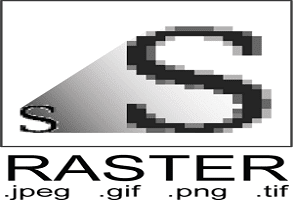Raster Image File Formats
Raster Image File Formats
The most common Raster image file formats, the
most important for cameras, printing, scanning,
and internet use, are JPG, TIF, PNG, and GIF.
•JPG
.JPG is the most used image file format. Digital cameras and web pages normally use JPG
files – because JPG heroically compresses the data to be very much smaller in the file.
However, JPG uses lossy compression to accomplish this feat, which is a strong downside.
A smaller file, yes, there is nothing like JPG for small, but this is at the cost of image quality.
This degree is selectable (with an option setting named JPG Quality), to be lower quality
smaller files, or to be higher quality larger files. In general today, JPG is rather unique in
this regard, using lossy compression allowing very small files of lower quality, whereas
almost any other file type uses lossless compression (and is larger). The meaning of Lossy
is discussed Below. The most common Raster image file formats are the most important
for cameras, printing, scanning, and internet use.
Frankly, JPG is used when small file size is more important than the maximum image
quality (web pages, email, memory cards, etc). But JPG is good enough in many cases,
if we don’t overdo the compression. Perhaps good enough for some uses even if we do
overdo it (web pages, etc). But if you are concerned with maximum quality for archiving
your important images, then you do need to know two things: 1) JPG should always choose
higher Quality and a larger file, and 2) do NOT keep editing and saving your JPG images
repeatedly, because more quality is lost every time you save it as JPG (in the form of added
JPG artifacts… pixels become colors they ought not to be – lossy). More at the JPG link
at page bottom.The most common Raster image file formats is the most important for cameras,
printing, scanning.
•PNG
It can replace GIF today (web browsers show both), and PNG also offers many options of
TIF too (indexed or RGB, 1 to 48-bits, etc). PNG was invented more recently than the others,
designed to bypass possible LZW compression patent issues with GIF, and since it was
more modern, it offers other options too (RGB color modes, 16 bits, etc).
One additional feature of PNG is transparency for 24-bit RGB images. Normally PNG files are
a little smaller than LZW compression in TIF or GIF (all of these use lossless compression, of
different types), but PNG is slower to read or write. That patent situation has gone away now,
but PNG remains excellent lossless compression. Less used than TIF or JPG, but PNG is
another good choice for lossless quality work.The most common Raster image file formats
is the most important for cameras, printing, scanning, and internet use.
•GIF
It was designed by CompuServe in the early days of computer 8-bit video, before JPG, for video
display at dial-up modem speeds. GIF discards all Exif data, and while GIF is fine for video
screen purposes, GIF does Not retain printing resolution values. GIF always uses lossless LZW
compression, but it is always an indexed color file (1 to 8-bits per pixel). GIF can have a palette
of 24-bit colors, but only 256 of them maximum (which colors depend on your image colors).
GIF is rather limited colors for color photos but is generally great for graphics. Repeating, don’t use
indexed color for color photos today, the color is too limited. GIF offers transparency and animation.
PNG and TIF files can also optionally handle the same indexed color mode that GIF uses,
but they are more versatile with other choices too (can be RGB or 16 bits, etc). But GIF is still
very good for web graphics (i.e., with a limited number of colors). For graphics of only a few
colors, GIF can be much smaller than JPG, with more clear pure colors than JPG).The most
common Raster image file formats is the most important for cameras.
•Camera RAW
These files are very important of course, but RAW files must be processed to regular formats
(JPG, TIF, etc) to be viewable and usable in any way. However, the point is that RAW offers
substantial benefit in doing that, one of which is we can choose our settings AFTER we can
see the image, and what it needs, and what helps it. The debate goes on, some cannot
imagine NOT taking advantage of the greater opportunities of RAW. Others think any
extra step is too much trouble, and are satisfied with JPG – my own biased opinion is they
just don’t know yet.
The most common Raster image file formats is the most important for cameras, printing,
scanning, and internet use. We could argue that there really is no concept of RAW files
from the scanner. Vuescan does offer an output called RAW, which is 16 bits, includes
the fourth Infrared noise correction channel data if any, and defers gamma correction.
Vuescan itself is the only post-processor for these. But scanner color images are already
RGB color, instead of Bayer pattern data like from cameras. Camera RAW images are
not RGB (the meaning of RAW), and must be converted to RGB for any use.
Source By:- https://www.animationcoursesahmedabad.com/blog/ahmedabad/
3d-animation/raster-image-file-formats/274/details
Thanks & Regards
KSHITIJ VIVAN AHMEDABAD
Kshitij Vivaan offers career courses in Animation, VFX, graphics, web designing &
gaming for students from different cities such as Gandhinagar. KSHITIJ VIVAN helps
these students get the best job placements according to their skills and talents to
get the best start to their Professional Careers.




Comments
Post a Comment